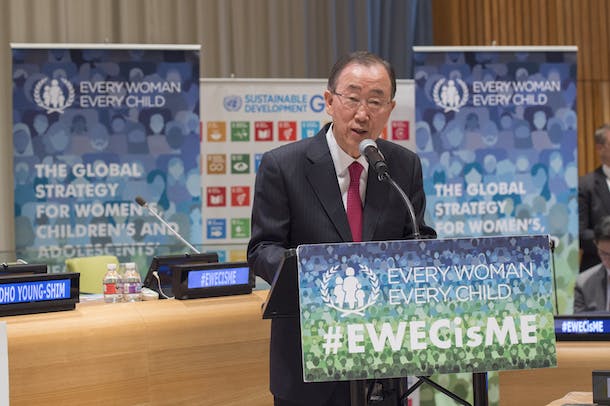
Recently, at an Every Woman Every Child event co-organized with UN Women and during the Commission on the Status of Women’s annual meeting, UN Secretary-General Ban Ki-moon reiterated his strong commitment to improving the health and wellbeing of women, children, and adolescents. Every Woman Every Child is an unprecedented global movement that mobilizes and intensifies international and national action by governments, the UN, multilateral groups, the private sector, and civil society to address the major health challenges facing women, children, and adolescents.
He urged everyone “to make a new commitment to Every Woman Every Child – or renew an existing one.” The Secretary-General then singled out three opportunities in May to show support: at the Fourth Global Women Deliver conference in Copenhagen; at the World Humanitarian Summit in Istanbul; and at the World Health Assembly in Geneva.
So far, more than 40 countries and 120 stakeholders have committed over $25 billion to achieve the Global Strategy for Women’s, Children’s, and Adolescents’ Health and to set the foundation for healthier, equal, and more prosperous lives for generations to come.
Responding to the Secretary-General’s call to action is essential to accelerate implementation of the Global Strategy, which was launched alongside the Sustainable Development Goals in September and presents a roadmap on ending all preventable deaths of women, children, and adolescents within a generation. The objectives of the Global Strategy align with the Sustainable Development Goals and are framed by three thematic pillars: Survive – end preventable deaths; Thrive – ensure health and well-being, and; Transform – expand enabling environments.
An operational framework accompanies the Global Strategy and serves as a resource for national governments and stakeholders whose contributions are vital to achieve results. It presents objectives to implement the Global Strategy at the country-level around nine action areas. For each action area there is a corresponding “ingredient” for action.
These strategies can – and should – build on existing country-level processes and plans already underway. For example, the Global Strategy calls for “robust country-led, multi-stakeholder accountability; independent review and unified reporting; and follow up action at all levels for women, children, and adolescents.”
To realize this vision, there is a need to strengthen country and global accountability frameworks, building on existing initiatives and aligning with reporting on the Sustainable Development Goals. Inclusive, transparent, and regular reviews of plans and resource utilization are key to accountability. And global accountability will need to be built up from country-level milestones.
Governments have the leadership and stewardship role for planning and implementing all of the ingredients for action. However, true country ownership occurs when governments work with other stakeholders within and beyond government. This includes civil society organizations, networks of young people, associations of health care professionals, research and training institutes, and the private sector.
Governments working with partners can strengthen community engagement and align around a common effort. Civil society groups and community members themselves can lead community engagement, participation, and advocacy efforts.
By working together, Every Woman Every Child partners have already saved the lives of millions of women and children and supported them to achieve their full potential.
Every partner has a role to play to advance a higher standard of implementation and accountability. Implementing the Global Strategy would achieve a remarkable transformation in health and sustainable development by 2030 for women, children, and adolescents everywhere.
Photo credit: UN Photo



 View All Blog Posts
View All Blog Posts